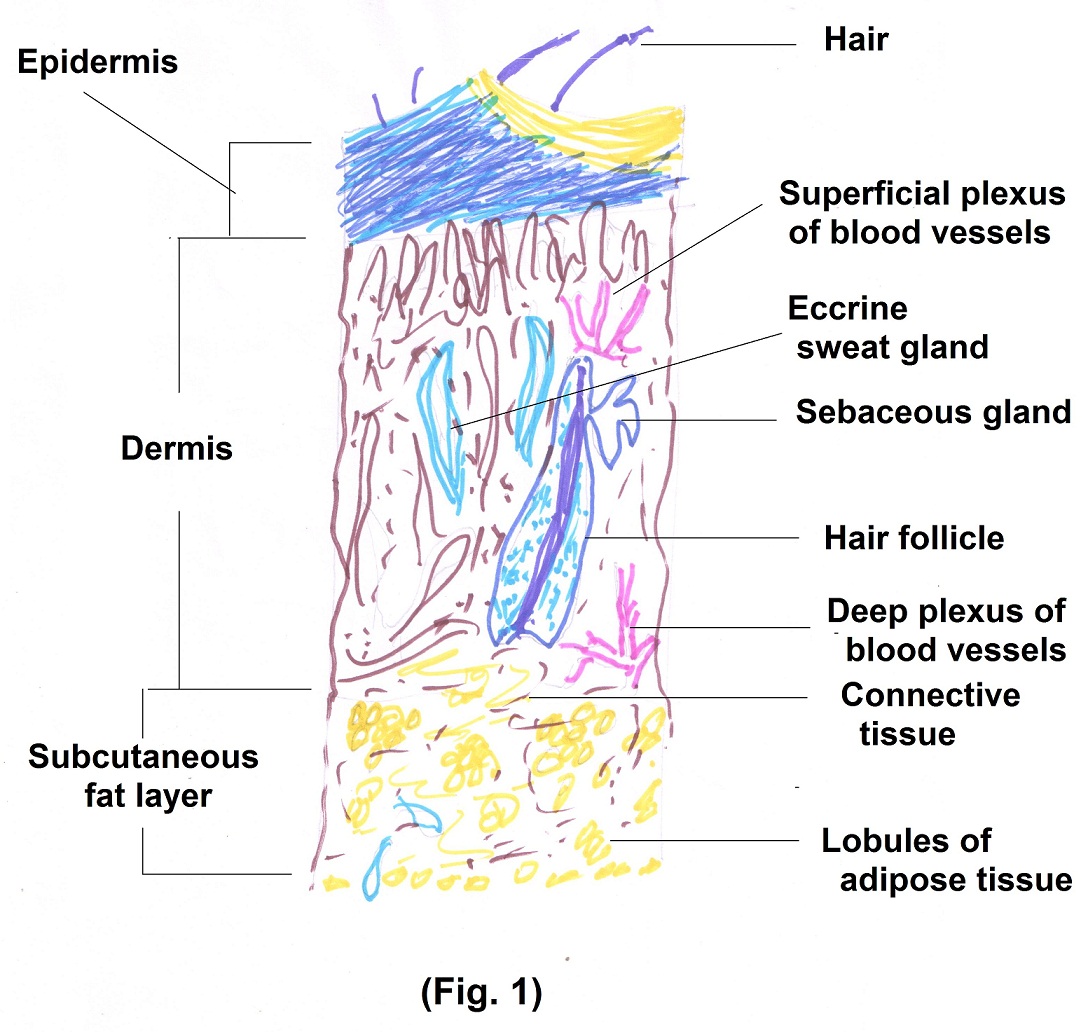Skin
The integumentary system (in-inward, tegere-to cover) is composed of the skin, hair, oil and sweat glands, nails and sensory receptors. Skin covers the external surface of the body. Of all the bodily organs, none is more easily visible and more exposed to infection and injury than the skin. Although its location makes it vulnerable to damage, from trauma, sunlight, microbes and pollutants in the environment, the skin’s protective features would ward off such damage.
The skin consists of two main layers – Epidermis and Dermis. (Fig. 1)

The superficial thinner portion, which is composed of epithelial tissue, is the epidermis. — The deeper, thicker connective tissue portion in the dermis.
While the Epidermis is avascular, the dermis is vascular. For this reason, if you cut only the epidermis there is no bleeding.
Deep to the dermis, but not part of the skin, is the subcutaneous layer. This layer consists of areolar and adipose tissue. The subcutaneous layer serves as a storage depot for fat and contains large blood vessels that supply the skin. This region (and sometimes the dermis) also contains nerve endings that are sensitive to pressure.
Let us study these layers in detail.
Epidermis
The epidermis contains 4 principal types of cells i.e. Keratinocytes, melanocytes, Langerhans cells and Merkel cells.
About 90% of epidermal cells are Keratinocytes and produces the protein keratin. Keratin is a tough, fibrous protein that helps protect the skin and underlying tissue from abrasions, heat, microbes and chemicals.
About 8% of the epidermal cells are melanocytes, which produce the pigment Melanin. Melanin contributes to skin color and absorbs damaging ultraviolet (UV) light.
Langerhans cells, also called epidermal dendritic cells, participate in immune responses by helping other cells of immune system to recognize an invading microbe and destroy it.
Merkel Cells are located in the deepest layer of epidermis, where they contact the flattened process of a sensory neuron (nerve cell) which helps in detecting touch sensation.
The Lipid rich secretion in keratinocytes acts as a water repellant, sealant, retarding loss and entry of water and entry of foreign materials.
Stratum Lucidum is a layer which is present only in the thick areas of skin such as the fingertips, palms and soles. It consists of 4 to 6 layers of flattened clear, dead Keratinocytes that contain large amount of Keratin and thickened plasma membranes. This probably provides an additional level of toughness in this region.
Stratum Corneumis the layer,consisting of an average of 25 to 30 layers of flattened dead Keratinocytes, but can range in thickness from a few cells in this skin to 50 or more cell layers in thick skin. They are the final product of the differentiation process of the Keratinocytes. The cells within each layer overlap one another like the scale on the skin of snake. In this outer stratum of the epidermis, cells are continuously shed and replaced by cells from the deeper strata. The multiple layers of dead cells help the stratum corneum to protect deeper layers from injury and microbial invasion. Constant exposure of skin to friction stimulates increased cell production and keratin production that results in the formation of a callus, an abnormal thickening of the stratum corneum.
The cells from basal layer are slowly pushed to the surface accumulating more and more keratin, a process called keratinization. The whole process of cells rising to the surface, becoming keratinized and slough off takes about 4 to 6 weeks in an average epidermis.
In psoriasis, a common, chronic skin disorder, keratinocytes divide and move more quickly. They are shed prematurely in as little as 7-10 days. The immature keratinocytes make an abnormal keratin, which forms silvery scales at the skin surface most often on the knees, elbows and scalp.
Dermis
It is the second deeper part of the skin; the Dermis is composed of dense irregular connective tissue containing collagen and elastic fibers. This woven network of fibers has great tensile strength. It is much thicker than the dermis, and this thickness varies from region to region in the body, reaching its greatest thickness on the palms and soles. Cells present in the dermis include predominantly fibroblasts, with few macrophages and adipocytes. Blood vessel, nerves, glands and hair follicles are embedded in the dermal layer.
The combination of collagen and elastic fibers provides the skin with strength, extensibility and the ability to return to original shape after stretching. The extensibility of skin can be readily scene around joints and in pregnancy and obesity.
